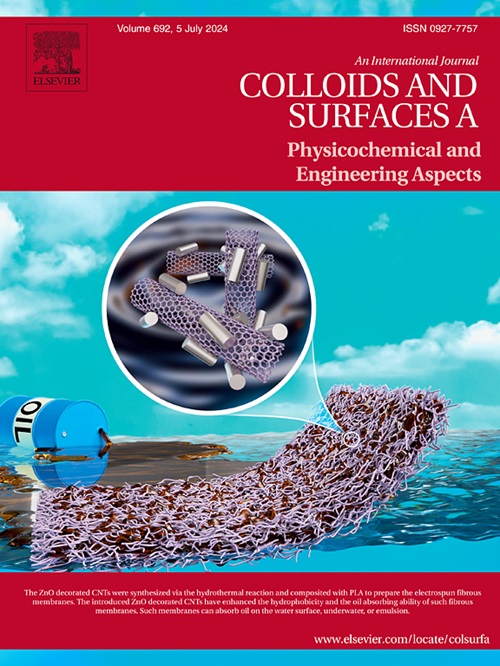利用乳液膜回收双氯芬酸:表面活性剂在传质过程中可能发挥的作用
IF 4.9
2区 化学
Q2 CHEMISTRY, PHYSICAL
Colloids and Surfaces A: Physicochemical and Engineering Aspects
Pub Date : 2024-10-29
DOI:10.1016/j.colsurfa.2024.135668
引用次数: 0
摘要
乳液膜(ELM)是在水溶液中萃取药物的一种有效方法,因为在通过高比表面积的膜相后,可以在高浓度的受体相中回收药物。这一过程的成功取决于系统配方和操作条件。配方中最重要的一个方面是添加表面活性剂,它可以稳定系统,也可以参与传质过程。最近有报道称,使用 Abil® EM 90 等聚合物表面活性剂会导致传质阻力。为了验证之前研究中观察到的这一现象,我们使用 ELM 技术分析了各种因素对溶解在水介质中的双氯芬酸(DCF)回收率的影响。研究得出结论:使用由 Abil® EM 90(2% w/V)、三辛胺(5% w/V)和十二烷组成的膜,以及由 NaOH(0.10 mol/L)形成的剥离相,可成功去除 DCF。在室温下以 15,000 rpm 的转速乳化 10 分钟,15 分钟后可去除 99% 以上的 DCF,30 分钟后可回收 18.45%。此外,研究还发现,表面活性剂的作用是导致 DCF 无法进入内相并保留在有机相中的主要原因。这可能是由于 Abil ® EM 90 和 DCF 之间存在强烈的分子间相互作用,并形成了复杂而稳定的界面结构,类似于水合双分子层,这有利于提高界面的刚性并保持药物的滞留。更好地了解表面活性剂在该系统中的作用,对于今后设计更高效、更稳定的 ELM 至关重要。有了这些知识,就能将该技术应用于更广泛的工艺,包括药物回收。因此,这项技术的最大优势将得以充分实现。本文章由计算机程序翻译,如有差异,请以英文原文为准。
Diclofenac recovery by means of using Emulsion Liquid Membranes: A possible role of surfactant in the mass transfer process
Emulsion Liquid Membranes (ELM) are a useful method for drug extraction in aqueous solution, as they allow their recovery in a highly concentrated acceptor phase after passing through a membrane phase with a high surface area. The success of this process depends on system formulation and operation conditions. One of the most important aspects in the formulation is the addition of a surfactant that stabilizes the system, which can also participate in the mass transfer process. Recently, resistance to mass transfer caused by the use of polymeric surfactants, such as Abil® EM 90, has been reported. To verify this phenomenon observed in previous studies, the effect of various factors on the recovery of diclofenac (DCF) dissolved in an aqueous medium was analyzed using the ELM technique. The study concluded that using a membrane consisting of Abil® EM 90 (2 % w/V), trioctylamine (5 % w/V), and dodecane, along with a stripping phase formed by NaOH (0.10 mol/L), results in successful DCF removal. When emulsified at 15,000 rpm for 10 minutes at room temperature, it is possible to remove over 99 % of DCF after 15 minutes and recover 18.45 % after 30 min. Furthermore, it was determined that the action of the surfactant is the main cause of the resistance to the passage of DCF to the internal phase and its retention in the organic phase, as had already been observed. This is probably due to strong intermolecular interactions between Abil ® EM 90 and DCF and the formation of a complex and stable interfacial structure, similar to a hydrated bilayer, which favors the rigidity of the interface and keeps the drug trapped. A better understanding of the role surfactants play in the system is essential for the future design of more efficient and stable ELMs. This knowledge will enable the adaptation of the technology to a wider range of processes, including drug recovery. As a result, the maximum benefits of this technology can be fully realized.
求助全文
通过发布文献求助,成功后即可免费获取论文全文。
去求助
来源期刊
CiteScore
8.70
自引率
9.60%
发文量
2421
审稿时长
56 days
期刊介绍:
Colloids and Surfaces A: Physicochemical and Engineering Aspects is an international journal devoted to the science underlying applications of colloids and interfacial phenomena.
The journal aims at publishing high quality research papers featuring new materials or new insights into the role of colloid and interface science in (for example) food, energy, minerals processing, pharmaceuticals or the environment.

 求助内容:
求助内容: 应助结果提醒方式:
应助结果提醒方式:


